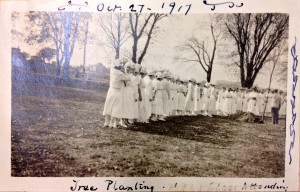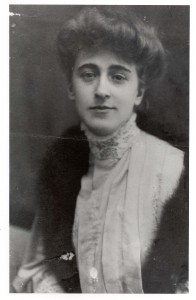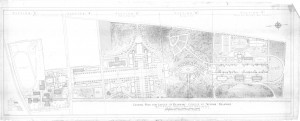With its purposefully placed trees, guiding brick paths, and symmetrical layout, the University of Delaware’s campus is picturesque. The development of the University’s campus as we know it traces its origins to one woman in particular: Marian C. Coffin. Since her work in the 1920s, the University of Delaware has expanded and evolved, but remains true to Coffin’s vision of a unified campus despite the division between the Men’s (north) and Women’s (south) campuses.
Marian Coffin was the nation’s first female landscape designer/architect. An M.I.T. graduate, Coffin completed many impressive commissions before her work at the University of Delaware, the largest of which were her designs for the gardens on Henry Francis du Pont’s Winterthur estate. After her work at Winterthur, du Pont introduced Marian Coffin to H. Rodney Sharp, a member of the University Board of Trustees. Upon Sharp’s recommendation, the Delaware Board of Trustees hired Coffin for the landscaping of the North and South Green (Hoffecker, Loyal Alumnus).
Before Coffin, landscaping of the University’s campus had been done by Frank Miles Day in 1917. With adjustments to walkways, plantings, and arrangements, Coffin transformed the campus landscape from Day’s formal style into one with “a more casual, romantic character” (Hail). Trees were planted beside paths, plants and flowers were placed to draw the eye, and purposefully built circles and ovals brought the Women’s and Men’s college together across the “no man’s land” between the campuses. Another contributor to Coffin’s work was Dean Robinson, head of the Women’s College, who insisted upon students helping to plant trees on campus. These trees would leave the female students with a feeling of permanence and accomplishment while improving their campus. Though several trees were removed in 1963 for the construction of Morris Library, some of the trees still remain today in the area just south of Alison Hall (Hail).

Tree planting ceremony in 1917 by the students of the Women’s College. Courtesy of the University Archives
Coffin’s designs created a sense of continuity from North to South Green, despite distinctly different landscapes. On the North Mall, American Elms were planted in orderly rows, creating a stately, formal appearance. As Hail states on the South Mall, Coffin used circular and oval arrangements to “allow a naturalistic flow to the two campuses.” Another distinct feature of the South Green was its diverse flora; the many plantings included honey locusts, American beech, and native flowering trees such as sweet magnolia. The trees and other plantings provide the campus with diverse displays of foliage year-round, adding to the sense of “naturalistic flow” Coffin sought to create at the Women’s College (Hail).
Today, Marian Coffin’s ideas are still used as the template for the campus landscaping as the college continues to grow and evolve. Though not all of her original designs have survived, the University of Delaware’s present-day campus is a testament to the work of Marian Coffin, who created a landscape that is both beautiful and functional, and one that we are proud to show off as the seasons change.
By Olivia Haslam and Izzy Okaya
Sources:
Hail, Michael W. “The Art of Landscaping.” The UD Messenger. Vol. 2.2 (1993). 4. Web. Oct. 13. 2014. http://www.udel.edu/PR/Messenger/93/2/40.html
Hoffecker, Carol. Familiar Relations: The du Ponts and the University of Delaware. n.p. n.d. Web. Oct. 13. 2014. http://www.udel.edu/aboutus/duPontFamily/index.html

